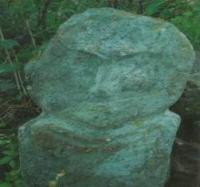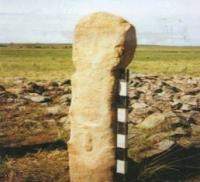You are here
Sanctuary Sarykol.



Best Petroglyphs Tours Kazakhstan.
“Books are the plane, and the train, and the road. They are the destination, and the journey. They are home”
Anna Quindlen,
Private Tours to East-Kazakhstan Petroglyphs.
The sanctuary Sarykol is located in 45 km to the south of the village Guard of the Abay Region of East Kazakhstan region. Represents a complex of barrows. The large role in detection of local features of Turkic culture in the territory of East Kazakhstan is played by funeral funeral complexes.
In this regard the group of objects No. 12, 13, 14 of a sanctuary Sarykol which are allocated from all barrows of a complex is of interest are isolated by an arrangement and differences of sepulchral constructions.
During field works on a cultural complex of Sarykol on stone fencing No. 12, 13 by sectors the stone embankment was removed, at the same time it was made a photo and graphic fixing of stones. During removal of chaotically lying stone embankment the big stone blocks concerning design features of a barrow of fencings were traced.
Barrow the fencing No. 12 has square shape the parties 8,4 x 8 m. Stones on perimeter lie in a row vertically. In a middle part of fencings stones lie randomly, and at the edges it is possible to track the stones which are accurately put at each other or vertically put.
On the parties of a barrow of a fencing there are black spots length about one meter shorter, than length of the parties of fencings. On these places kindled a fire for holding ritual ceremonies therefore stones, from a laying of fencings, lay lower than the level of a day surface. In a northeast part bones of cattle are found.
In a northern part of a barrow under stones of a design the dense clay shaft by width in meter and height about a half a meter is traced. Initially the design of fencings was separate and only centuries later stones of the top part of a laying rolled down between construction walls, creating illusion of a barrow.
As the barrow a fencing No. 12 is the basic in this complex, in east part at distance in 1,40 m from an stone fencing the stone sculpture is located. A sculpture with an accurate outline of the Mongolian man's face.
The head is separated from a trunk by the image of a neck. Face outlines - eyes, eyebrows, a nose, moustaches and a beard are executed in a uniform bas-relief. Hair are combed back and braided in several braids.
On a breast the breastplate of a rhombic form is represented. Hands are not represented, only outlines are visible on each side. The sculpture is made of red granite 2,44 m high, 0,41 - 0,36 m wide, thickness - 0,37 - 0,29 m.
Such type of a stone sculpture is widespread among ancient Turkic peoples. They can be distinguished only on technology of knockout of a bas-relief of the person. Having studied materials of researchers on this subject, the conclusion is drawn that this sculpture is ancient Turkic.
At careful cleaning around a sculpture to the North on 0,45 m almost on a day surface the silver stripe with ornaments in the form of six petals of a camomile was found. Stripe with a diameter about 20 mm and board of 3 mm high.
As a result of excavation from East side of a fencing No. 12 almost on a day surface the black spot of a P-shaped form twisting a stone sculpture is revealed. Possibly, this extension near a stone sculpture had purely ritual value.
Kindling a fire in the area of this spot for communication with the other world, shamans performed rituals. When cleaning this spot from a northern part the bead of red color (lazurite), and from South side - a jaw of a horse was found.
During excavation in a fencing No. 13 which has square shape with sizes of 7 x 8 m after cleaning of the top layer big and average stone plates and long blocks are also found. And yes In stones lie in east part of sectors in two ranks vertically, in the lower part cost directly on perimeter, the top part an inclination outside.
These stones, just as in an stone fencing No. 12, lie lower than the level of a day surface. Being once a part of a design, as a result of centuries-old natural influences they fell outside in the same deepenings along a burial mound construction which were intended for a ritual ceremony.
Fencing construction between an stone fencing No. 14 underwent strong destruction therefore its design is very badly traced. In a middle part of the sector In fencings No. 13 as a result of cleaning a bit is found. A bit iron, two-member, one part as a result of a severe erosion is destroyed.
This bit is similar to those that were found in a treasure under a stone sculpture. Safety is average. In the middle of a northern wall between the first and second laying of stones the silver jug is found. It has height of 78 mm, diameter of a mouth of 23 mm, diameter of a trunk of 37 mm, diameter of a bottom of 34 mm, diameter of the handle of 16 mm.
Along with the funeral funeral constructions relating to various cultural chronological periods several congestions of rock paintings were revealed. The petroglyphs applied on a surface of separate exits of radical breeds are subjected to a severe erosion.
Drawings of horses of an era of late bronze, especially those which are executed in Seyminsky Turbinsky style, with emphasized and a certain stone fencing to model shape of the head, a neck and the case are distinguished to some from them peculiar.
They make the multifigured composition divided by rocky cracks.
Literature:
1. www.madenimura.kz - "Madenimura", information resource about cultural property of Kazakhstan
2. Samashev Z., Sapashev O., Oralbay E., Tulegenov E., Isin A., Saylaubay E. Monuments of monumental art of East Kazakhstan (antiquity and Middle Ages). - Almaty, 2010.
Authority and photos:
KGU "VKO уч. on protection of IKN. http://yka.kz/publ/svjatilishhe_sarykol/38-1-0-3398







